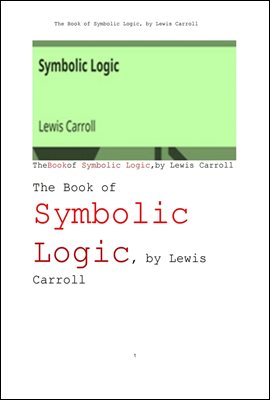
기호 논리학.Symbolic Logic, by Lewis Carroll
- 저자Lewis Carroll 저
- 출판사뉴가출판사
- 출판일2020-07-24
- 등록일2020-12-21
- SNS공유


- 파일포맷PDF
- 파일크기1MB
- 공급사YES24
-
지원기기
PC
PHONE
TABLET
프로그램 수동설치
전자책 프로그램 수동설치 안내
아이폰, 아이패드, 안드로이드폰, 태블릿,
보유 1, 대출 0,
예약 0, 누적대출 8, 누적예약 0
책소개
기호 논리학 mathematical logic, 즉 , 심벌릭 로직 symbolic logic .이책은 이상한 나라의 엘리스를 쓴 영국작가인 루이스 캐롤이 기술한 책.
수학적 연산을 할 수 있도록 논리 형식을 기호화하여 다루는 논리학을 지칭함. 수학적 이론 가운데 대수학代數學 에서처럼 언어 대신 기호를 활용하여 언어의 모호성이나 제약을 없애고 논리 체계의 순수성과 엄밀성에 치중하여 논리의 구조를 밝히려고 하는 형식 논리학이며 이는 19세기 후반에 러셀 등에 의하여 논리학의 주요 부분으로 시작해 발달.
2.
BOOK IV.
THE TRILITERAL DIAGRAM.
CHAPTER I.
SYMBOLS AND CELLS.
Change of Biliteral into Triliteral Diagram 39
The xy- Class subdivided into ‘the xym- Class’ and ‘the xym
′- Class’ 40
pg_xxiii
The Inner and Outer Cells of the North- West Quarter assigned to these
Classes 〃
The xy
′- Class, the x
′
y- Class, and the x
′
y
′- Class similarly subdivided 〃
The Inner and Outer Cells of the North- East, the South- West, and the
South- East Quarter similarly assigned 〃
The Inner Square and the Outer Border have thus been assigned to ‘the
m- Class’ and ‘the m
′- Class’ 〃
Rules for finding readily the Compartment, or Cell, assigned to any given
Attribute or Attributes 〃
Table IV. Attributes of Classes, and Compartments, or Cells, assigned to
them 42
CHAPTER II.
REPRESENTATION OF PROPOSITIONS IN TERMS OF x AND m, OR OF y
AND m.
§ 1.
Representation of Propositions of Existence in terms of x and m, or of y
and m.
The Proposition “ Some xm exist” 43
Seven other similar Propositions 〃
The Proposition “ No xm exist” 44
Seven other similar Propositions 〃
§ 2.
Representation of Propositions of Relation in terms of x and m, or of y
and m.
The Pair of Converse Propositions “ Some x are m” = “ Some m are x” 〃
Seven other similar Pairs 〃
The Pair of Converse Propositions “ No x are m” = “ No m are x” 〃
Seven other similar Pairs 〃
The Proposition “ All x are m” 45
Fifteen other similar Propositions 〃
Table V. Representations of Propositions in terms of x and m 46
Table VI. Representations of Propositions in terms of y and m 47
Table VII. Representations of Propositions in terms of x and m 48
Table VIII. Representations of Propositions in terms of y and m 49
pg_xxiv
CHAPTER III.
REPRESENTATION OF TWO PROPOSITIONS OF RELATION, ONE IN
TERMS OF x AND m, AND THE OTHER IN TERMS OF y AND m, ON THE
SAME DIAGRAM.
The Digits “ I” and “ O” to be used instead of Red and Grey Counters 50
Rules 〃
Examples worked 〃
CHAPTER IV.
INTERPRETATION, IN TERMS OF x AND y, OF TRILITERAL DIAGRAM,
WHEN MARKED WITH COUNTERS OR DIGITS.
Rules 53
Examples worked 54
BOOK V.
SYLLOGISMS.
CHAPTER I.
INTRODUCTORY.
‘Syllogism’ 56
‘Premisses’ 〃
‘Conclusion’ 〃
‘Eliminands’ 〃
‘Retinends’ 〃
‘Consequent’ 〃
The Symbol “ ∴” 〃
Specimen- Syllogisms 57
CHAPTER II.
PROBLEMS IN SYLLOGISMS.
§ 1.
Introductory.
‘Concrete’ and ‘Abstract’ Propositions 59
Method of translating a Proposition from concrete into abstract form 〃
Two forms of Problems 〃
§ 2.
Given a Pair of Propositions of Relation, which contain between them a
Pair of codivisional Classes, and which are proposed as Premisses: to
ascertain what Conclusion, if any, is consequent from them.
Rules 60
Examples worked fully 〃
The same worked briefly, as models 64
§ 3.
Given a Trio of Propositions of Relation, of which every two contain a Pair
of codivisional Classes, and which are proposed as a Syllogism: to
ascertain whether the proposed Conclusion is consequent from the
proposed Premisses, and, if so, whether it is complete.
Rules 66
Examples worked briefly, as models 〃
목차
기호 논리학.Symbolic Logic, by Lewis CarrollCONTENTS
BOOK I.
THINGS AND THEIR ATTRIBUTES.
CHAPTER I.
INTRODUCTORY.
PAGE
‘Things’ 1
‘Attributes’ 〃
‘Adjuncts’ 〃
CHAPTER II.
CLASSIFICATION.
‘Classification’ 1½
‘Class’ 〃
‘Peculiar’ Attributes 〃
‘Genus’ 〃
‘Species’ 〃
‘Differentia’ 〃
‘Real’ and ‘Unreal’, or ‘Imaginary’, Classes 2
‘Individual’ 〃
A Class regarded as a single Thing 2½
pg_xvi
CHAPTER III.
DIVISION.
§ 1.
Introductory.
‘Division’ 3
‘Codivisional’ Classes 〃
§ 2.
Dichotomy.
‘Dichotomy’ 3½
Arbitrary limits of Classes 〃
Subdivision of Classes 4
CHAPTER IV.
NAMES.
‘Name’ 4½
‘Real’ and ‘Unreal’ Names 〃
Three ways of expressing a Name 〃
Two senses in which a plural Name may be used 5
CHAPTER V.
DEFINITIONS.
‘Definition’ 6
Examples worked as models 〃
pg_xvii
BOOK II.
PROPOSITIONS.
CHAPTER I.
PROPOSITIONS GENERALLY.
§ 1.
Introductory.
Technical meaning of “ some” 8
‘Proposition’ 〃
‘Normal form’ of a Proposition 〃
‘Subject’, ‘Predicate’, and ‘Terms’ 9
§ 2.
Normal form of a Proposition.
Its four parts:?
(1) ‘Sign of Quantity’ 〃
(2) Name of Subject 〃
(3) ‘Copula’ 〃
(4) Name of Predicate 〃
§ 3.
Various kinds of Propositions.
Three kinds of Propositions:?
(1) Begins with “ Some” . Called a ‘Particular’ Proposition: also a
Proposition ‘in I’ 10
(2) Begins with “ No” . Called a ‘Universal Negative’ Proposition: also
a Proposition ‘in E’ 〃
(3) Begins with “ All” . Called a ‘Universal Affirmative’ Proposition:
also a Proposition ‘in A’ 〃
pg_xviii
A Proposition, whose Subject is an Individual, is to be regarded as
Universal 〃
Two kinds of Propositions, ‘Propositions of Existence’, and ‘Propositions
of Relation’ 〃
CHAPTER II.
PROPOSITIONS OF EXISTENCE.
‘Proposition of Existence ’ 11
CHAPTER III.
PROPOSITIONS OF RELATION.
§ 1.
Introductory.
‘Proposition of Relation’ 12
‘Universe of Discourse,’ or ‘Univ.’ 〃
§ 2.
Reduction of a Proposition of Relation to Normal form.
Rules 13
Examples worked 〃
§ 3.
A Proposition of Relation, beginning with “All”, is a Double Proposition.
Its equivalence to two Propositions 17
pg_xix
§ 4.
What is implied, in a Proposition of Relation, as to the Reality of its
Terms?
Propositions beginning with “ Some” 19
Propositions beginning with “ No” 〃
Propositions beginning with “ All” 〃
§ 5.
Translation of a Proposition of Relation into one or more Propositions of
Existence.
Rules 20
Examples worked 〃
BOOK III.
THE BILITERAL DIAGRAM.
CHAPTER I.
SYMBOLS AND CELLS.
The Diagram assigned to a certain Set of Things, viz. our Univ. 22
Univ. divided into ‘the x- Class’ and ‘the x
′- Class’ 23
The North and South Halves assigned to these two Classes 〃
The x- Class subdivided into ‘the xy- Class’ and ‘the xy
′- Class’ 〃
The North- West and North- East Cells assigned to these two Classes 〃
The x
′- Class similarly divided 〃
The South- West and South- East Cells similarly assigned 〃
The West and East Halves have thus been assigned to ‘the y- Class’ and
‘the y
′- Class’ 〃
Table I. Attributes of Classes, and Compartments, or Cells, assigned to
them 25
pg_xx
CHAPTER II.
COUNTERS.
Meaning of a Red Counter placed in a Cell 26
Meaning of a Red Counter placed on a Partition 〃
American phrase “ sitting on the fence” 〃
Meaning of a Grey Counter placed in a Cell 〃
CHAPTER III.
REPRESENTATION OF PROPOSITIONS.
§ 1.
Introductory.
The word “ Things” to be henceforwards omitted 27
‘Uniliteral’ Proposition 〃
‘Biliteral’ do. 〃
Proposition ‘in terms of’ certain Letters 〃
§ 2.
Representation of Propositions of Existence.
The Proposition “ Some x exist” 28
Three other similar Propositions 〃
The Proposition “ No x exist” 〃
Three other similar Propositions 29
The Proposition “ Some xy exist” 〃
Three other similar Propositions 〃
The Proposition “ No xy exist” 〃
Three other similar Propositions 〃
The Proposition “ No x exist” is Double, and is equivalent to the two
Propositions “ No xy exist” and “ No xy
′ exist” 30
pg_xxi
§ 3.
Representation of Propositions of Relations.
The Proposition “ Some x are y” 〃
Three other similar Propositions 〃
The Proposition “ Some y are x” 31
Three other similar Propositions 〃
Trio of equivalent Propositions, viz. “ Some xy exist” = “ Some x are
y” = “ Some y are x” 〃
‘Converse’ Propositions, and ‘Conversion’ 〃
Three other similar Trios 32
The Proposition “ No x are y” 〃
Three other similar Propositions 〃
The Proposition “ No y are x” 〃
Three other similar Propositions 〃
Trio of equivalent Propositions, viz. “ No xy exist” = “ No x are y” = “ No y
are x” 33
Three other similar Trios 〃
The Proposition “ All x are y” is Double, and is equivalent to the two
Propositions “ Some x are y” and “ No x are y
′” 〃
Seven other similar Propositions 34
Table II. Representation of Propositions of Existence 34
Table III. Representation of Propositions of Relation 35
CHAPTER IV.
INTERPRETATION OF BILITERAL DIAGRAM, WHEN MARKED WITH
COUNTERS.
Interpretation of 36
And of three other similar arrangements 〃
pg_xxiiInterpretation of 〃
And of three other similar arrangements 〃
Interpretation of 37
And of three other similar arrangements 〃
Interpretation of 〃
And of three other similar arrangements 〃
Interpretation of 〃
And of three other similar arrangements 〃
Interpretation of 〃
And of seven other similar arrangements 38

















